UCLA researchers developed a method to shape light pulses by creating physical networks composed of specially engineered photonic layers. Networks built on similar concepts, already capable of all-optical classification and image recognition, suggest that applications for the new technology span computing and AI.
The researchers created diffractive optical networks that take an input light pulse and pass through 3D-printed layers designed by deep learning, which then shape the output pulse leaving the optical network in a desired temporal waveform. The network was demonstrated in the terahertz region of the electromagnetic spectrum for the first time, according to the researchers, showing a synthesis of various forms of terahertz pulses.
In accurately controlling the phase and amplitude of a broadband input pulse over a continuum of wavelengths, the researchers generated different pulse shapes, with differing pulse widths.
Passive diffractive layers that do not consume power and that can directly engineer terahertz pulses generated through, for instance, quantum cascade lasers, solid-state circuits, and particle accelerators made up the approach. The demonstrated method was versatile — easily adapted to engineer terahertz pulses regardless of beam quality or polarization state.

Artistic depiction of an optical diffractive network that shapes pulses of light. Inset: A 3D-printed optical diffractive network that is used to engineer THz pulses. Credit: UCLA Engineering Institute for Technology Advancement.
According to Aydogan Ozcan, Volgnau Chair for Engineering Innovation and a Chancellor’s Professor of Electrical and Computer Engineering at UCLA, the framework can be applied to other parts of the electromagnetic spectrum to shape optical pulses. He believes the work will find broad applications in various venues where light pulses are used — in ultrafast imaging, spectroscopy, and optical telecommunications.
The research was published in Nature Communications (www.doi.org/10.1038/s41467-020-20268-z).